
LSC – It Doesn’t Suck! by Andi Q. '25
Reject digital, return to 35 mm analogue
Have you ever wanted to be a performer but can’t sing or dance? Why not put on a show from the comfort of the Lecture Series Committee projection booth? With training from our highly qualified projectionists, you’ll be running the show on your own in no time. Just follow the link on the screen or talk to one of our personnel after the show. LSC – it doesn’t suck!
I’d never been a big fan of film back in high school, but watching the LSC intro before Jojo Rabbit gave me the urge to become a projectionist for the club. After all, I reasoned, college is a time to try out new things. I signed up for a training slot, and before I knew it, I was projecting Knives Out on my own just a few weeks later!
However, I soon realized that the intro, which included clips of people working with 35 mm film, was a bit outdated. These days, movies are primarily projected digitally, with computers automating almost every step. When I joined, LSC hadn’t used physical film since 2015. That would all change in the following semester, thanks to the brilliant LSC chair at the time, who resolved to do at least one film screening before graduation.
I was lucky enough to help with that first 35 mm film screening of Howl’s Moving Castle; it was a bit traumatizing and I forgot to document the process, but it still was an incredible experience. About two weeks ago, I got a refresher on 35 mm projection for the Spirited Away screening that weekend and remembered to take some pictures this time.
Without further ado, here’s a brief guide to 35 mm film projection for LSC!
What is 35 mm film?
Two thousand feet of colour film stock, 35 mm wide, and pulled through a projector at a constant 24 frames per second. That gives you one reel of film – multiply that by 8, and you’ve got all 125 minutes of Spirited Away.
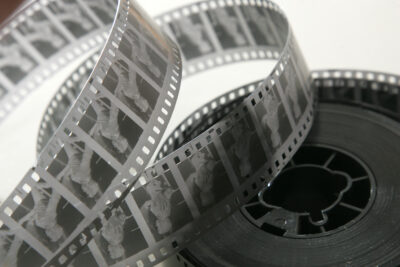
35 mm film. By Runner1616 – film izle, CC BY-SA 3.0, https://commons.wikimedia.org/w/index.php?curid=19318310
To project all these reels with no noticeable breaks in-between, we alternate between two separate projectors pointed at the same screen. We use pairs of cue dots to coordinate them synchronously; the first dot tells us to start the motor, and the second dot tells us to switch projectors:
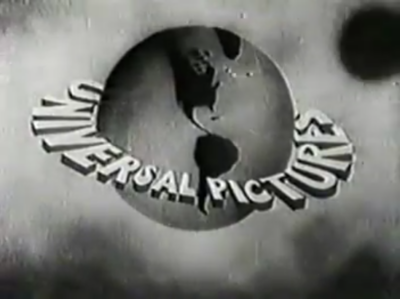
A cue dot on a movie frame. By Rotareneg – en:Image:35mm_film_audio_macro.jpg, CC BY-SA 3.0, https://commons.wikimedia.org/w/index.php?curid=1210853
For some reason, time is represented in two different ways in the film industry. There are real seconds, and then there are “academy seconds”. One academy second corresponds to one foot of film, which is 16 frames or ⅔ seconds. Pretty confusing, but you’ll get used to it relatively quickly.
The film also contains audio data in the space not taken up by pictures. There are generally four audio encodings present01 https://xkcd.com/927/ – three digital and one analogue:
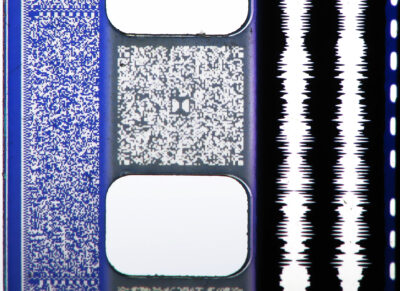
The four audio encodings on 35 mm film. By Rotareneg – en:Image:35mm_film_audio_macro.jpg, CC BY-SA 3.0, https://commons.wikimedia.org/w/index.php?curid=1210853
Fun fact: Dolby Digital’s encoding algorithm is so good that they can afford to print their logo in the middle of each square between sprocket holes. What a way to flex your technology!
Some people prefer film over digital because of nostalgia, while others enjoy that someone in the projection booth is physically responsible for their moviegoing experience. But whatever the reason, everyone agrees it’s a nice change from the digital projection that dominates theatres these days.
Pre-screening
First things first, we need to inspect the film. Our goals here are twofold – to check the positions of cue dots and to find (and fix) bad splices.
We check for cue dots in advance to know how to position the starting frame when we’re threading the film through the projector:
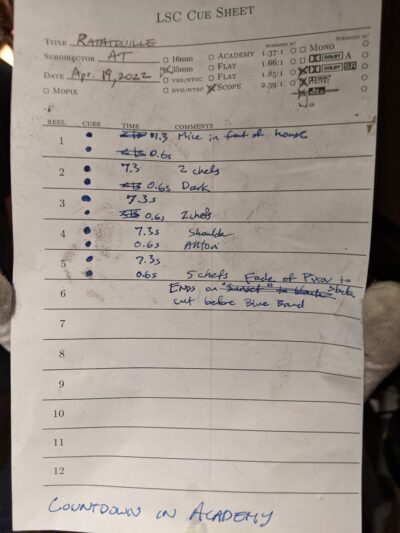
An example of a cue sheet for Ratatouille last semester
Cue dots are easy to find because they’re at the end of the film reel, usually at 0.75 and 8 seconds (18 and 192 frames) before the final frame. We also have a frame counter device to make this even easier:
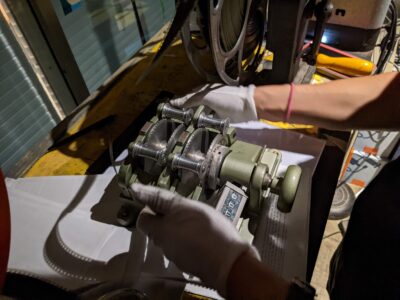
LSC’s frame counter device
Fun fact: our copy of Spirited Away’s 5th reel had a dot near the middle for some reason. Luckily(?), I was distracted at that point of the screening and missed the erroneous cue.
Splices are parts of the film that have been cut and joined together manually. These splices are sometimes floppy or unstable, which could lead to the film getting jammed during projection. This would break our projectors and destroy the film through overexposure – not the sort of BOGO deal you’d want to get. Splices exist for a variety of reasons, but one of the main reasons is “plattering” – when a cinema splices all the reels together into one giant reel:

The size of an IMAX film platter; IMAX is 70 mm film. By Philip Jaeger, https://evergreenmuseum.wordpress.com/tag/imax/
They do this so that they don’t need projectionists to handle changeovers. Plattering sounds good in theory, but they have to cut and splice the film into separate smaller reels before returning it to the distributor. This is where the errors creep in.
You can physically feel splices when running the film through your fingers because they’re joined with scotch tape; likewise, we use scotch tape to repair them. Not the most high-tech solution, but it works for our purposes.
Now that you know all about inspecting film, let’s get to it!

“Am I doing it right?”
Woah, slow down there, bucko! Remember to wear cotton gloves to avoid scratching and gunking up the film.
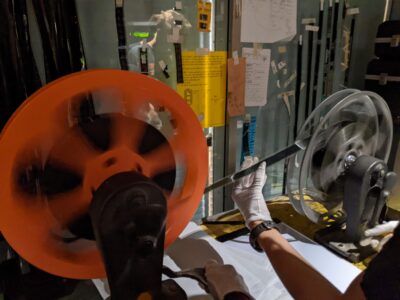
Inspecting film
Much better! These gloves are conductive, so you can still use your phone while wearing them. And finally, we rewind the film (with the rewinder machine) after finishing:
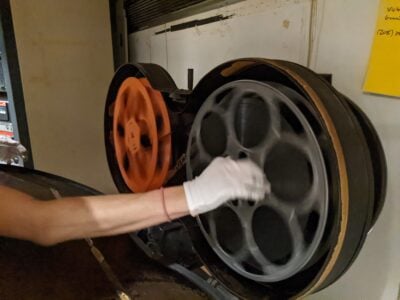
It’s rewind time!
Great – now we’re ready to do a test screening to ensure there are no egregious errors and then show the movie to an audience!
Showtime!
There are two main things that projectionists do during a screening – threading the film through the projector and watching for cue dots to handle changeovers.
We usually thread the first two reels of the film before the movie starts, but each subsequent one has to be handled within 20 minutes of its start. With practice, this process is pretty fast and streamlined, but it’s intense for a first-time projectionist. (I was originally planning to have an interactive applet to demonstrate threading, but WordPress doesn’t like me, so here’s a static image instead:)
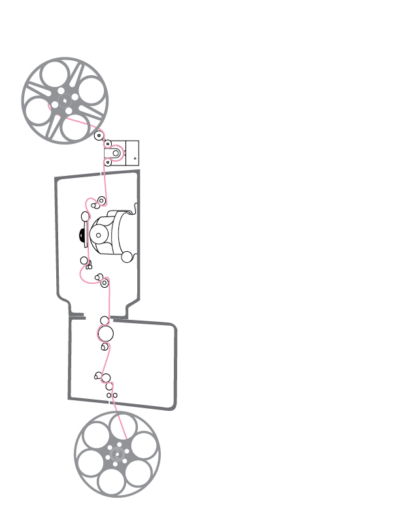
How to thread the projector
Pretty complicated, right? Fortunately for us projectionists, there’s a handy chart taped to the side of each projector that shows the threading diagram:
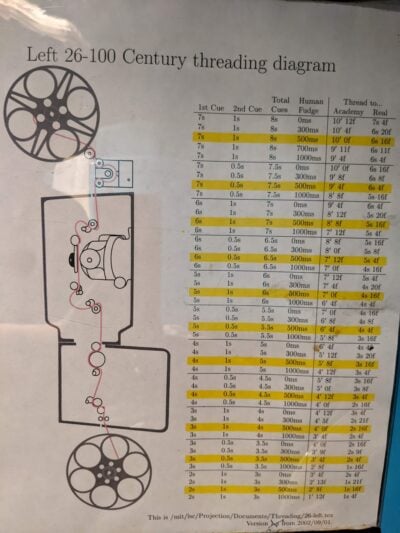
Thanks, past projectionists, for figuring this out
This chart and little numbers/diamonds on the film also tell us which frame should be aligned before we start the motor:
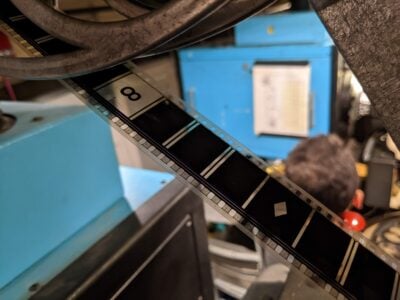
Very convenient
Watching for cue dots is a lot more straightforward. We just have to stare at the top right corner until we see them flash. The catch is that each dot flashes for only 4 frames (0.17 seconds); blink and you’ll miss it. Test your reaction time with the applet below!
Motor score: N/A
Changeover score: N/A
Keeping our eyes fixed on the top of the frame without blinking isn’t the most fun way to watch a movie, so we don’t do that. Instead, the projectors have mechanisms02 The mechanism takes advantage of the fact that the angular speed of the reel increases as it gets played. Pretty neat 8.01 moment that ring a bell when there’s 1 minute of film left, letting us know to prepare for the next changeover. Missing a changeover isn’t the end of the world, but it’s tradition for the audience to yell “LSC sucks!” in the rare event that it does happen (speaking from experience 🥲).
Congratulations – you now (vaguely) know how to put on a show in the comfort of the LSC projection booth! Remember, LSC – it doesn’t suck!
- https://xkcd.com/927/ back to text ↑
- The mechanism takes advantage of the fact that the angular speed of the reel increases as it gets played. Pretty neat 8.01 moment back to text ↑